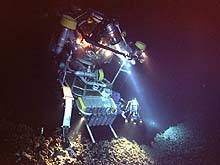Operation Deep Scope: Seeing with "New Eyes"
August 7-17, 2004
News Flash:The deep sea is a dark frontier. Many of our attempts at shedding light on the mysteries at the ocean's depths have been clouded, at best. What we can't see can elude us. How many marine animals have swum out of our nets? Evaded our bright and noisy submersibles? Or simply escaped our notice? In order to discover these creatures, and learn more about how they have adapted to life in the ocean darkness, we must explore in new ways. Earth’s final frontier demands that we see with "new eyes."
Operation Deep Scope was dedicated to seeing with “new eyes." This cruise, aboard the R/V Seward Johnson II, featured the use of new and one-of-a-kind equipment. The innovative and advanced camera systems, for example, made it easier to see animals under extremely dim light, without disturbing them. We also deployed newly designed light-tight traps in hopes of bringing some deep-sea animals -- perhaps ones we've never before seen -- to the surface, alive and with their remarkable eyes intact.
The site of this exploration, the northern Gulf of Mexico, is one of the most geologically complex regions on the planet. Consisting of basins, canyons, escarpments, and seeps, this region is far-better suited to exploration by submersible than by traditional sampling with nets and trawls. It is also an area of intense biological interest, thanks to the recent discovery of rich communities of tubeworms, associated predators, and other organisms, whose food web is based on chemicals from methane seeps (rather than sunlight).
The Operation Deep Scope science team explored each of these sites with our “new eyes.” We measured and characterized the light, both from the sun and bioluminescence, which was found in these ecosystems. Light has been described as the most powerful selective force in evolutionary history. Understanding how animals have adapted to the light in their environments -- to see and be seen (or not be seen) -- will provide new insight into the nature of life in these unusual communities. Additional information is available on the Harbor Branch Web site
Background information for this exploration can be found on the left side of the page. Daily updates are included below. More detailed logs and summaries of exploration activities are found on the right.
Updates & Logs
Click images or links below for detailed mission logs.
 Mission Summary Deep
Scope has peered
into the depths of the ocean with new technological eyes and
revealed remarkable findings.
Mission Summary Deep
Scope has peered
into the depths of the ocean with new technological eyes and
revealed remarkable findings.  August 16, 2004 The submersible team collects a fish with green fluorescent lenses. Learn how scientists measure the color of light that passes through these special eyes.
August 16, 2004 The submersible team collects a fish with green fluorescent lenses. Learn how scientists measure the color of light that passes through these special eyes.  August 15, 2004 How do you play hide and seek where there's no place to hide? Learn how animals hide in the open ocean.
August 15, 2004 How do you play hide and seek where there's no place to hide? Learn how animals hide in the open ocean. August 14, 2004 "Peep"
into the chemistry of sediment outside tubeworm colonies, and read
about the challenges facing scientists that collect
deep-sea samples.
August 14, 2004 "Peep"
into the chemistry of sediment outside tubeworm colonies, and read
about the challenges facing scientists that collect
deep-sea samples.  August 13, 2004 A cold front turns the Gulf of Mexico's surface from "glass" to 10-ft swells. All dive operations are temporarily cancelled.
August 13, 2004 A cold front turns the Gulf of Mexico's surface from "glass" to 10-ft swells. All dive operations are temporarily cancelled. August 12, 2004 What are the tricks of vision and camouflage that animals use to survive in a dark environment?
August 12, 2004 What are the tricks of vision and camouflage that animals use to survive in a dark environment?  August 11, 2004 Have you ever walked into a dark room? Did you let the door close behind you and embrace the darkness, or did you find a source of light? Learn how scientists explore in a world void of light.
August 11, 2004 Have you ever walked into a dark room? Did you let the door close behind you and embrace the darkness, or did you find a source of light? Learn how scientists explore in a world void of light.  August 10, 2004 Researchers use the Johnson-Sea-Link to search for fluorescing animals at the Brine Pool. Read about their discoveries.
August 10, 2004 Researchers use the Johnson-Sea-Link to search for fluorescing animals at the Brine Pool. Read about their discoveries.  August 9, 2004 Join the team on its encounter with slimy hagfish and a magnificent six-gill shark.
August 9, 2004 Join the team on its encounter with slimy hagfish and a magnificent six-gill shark.  August 8, 2004 The Eye-in-the-Sea camera system is deployed on the edge of a unique deep-sea habitat for the very first time.
August 8, 2004 The Eye-in-the-Sea camera system is deployed on the edge of a unique deep-sea habitat for the very first time.  August 7, 2004 Only eight hours into the mission, the
crew moves
to Plan B and reschedules dives.
August 7, 2004 Only eight hours into the mission, the
crew moves
to Plan B and reschedules dives.
























